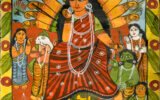
March 24-25-26 2024 Prelims Practice Questions (PPQs)
Subscribe to Never Miss an Important Update! Assured Discounts on New Products!
Must Join PMF IAS Telegram Channel & PMF IAS History Telegram Channel
- These Prelims Practice Questions (PPQs) are based on PMF IAS Daily Current Affairs.
- The daily current affairs are uploaded every day by 8 PM. You can read the Daily Current Affairs from here.
- Subscribers of the “Current Affairs” course can Download Daily Current Affairs in PDF/DOC from here.
[Quiz] Daily Prelims Practice Questions (PPQs) – March 24-25-26 2024
0 of 10 questions completed
Questions:
- 1
- 2
- 3
- 4
- 5
- 6
- 7
- 8
- 9
- 10
Information
These MCQs are based on PMF IAS Daily Current Affairs. The daily current affairs are uploaded every day by 8 PM. You can read the Daily Current Affairs from here. Subscribers of the “Current Affairs” course can Download Daily Current Affairs in PDF/DOC from here.
You have already completed the Test before. Hence you can not start it again.
Test is loading...
You must sign in or sign up to start the Test.
You have to finish following quiz, to start this Test:
Your results are here!! for" [Quiz] Daily Prelims Practice Questions (PPQs) – March 24-25-26 2024 "
0 of 10 questions answered correctly
Your time:
Time has elapsed
Your Final Score is : 0
You have attempted : 0
Number of Correct Questions : 0 and scored 0
Number of Incorrect Questions : 0 and Negative marks 0
| Average score |
|
| Your score |
|
-
Not categorized
You have attempted: 0
Number of Correct Questions: 0 and scored 0
Number of Incorrect Questions: 0 and Negative marks 0
| Pos. | Name | Entered on | Points | Result |
|---|---|---|---|---|
| Table is loading | ||||
| No data available | ||||
- 1
- 2
- 3
- 4
- 5
- 6
- 7
- 8
- 9
- 10
- Answered
- Review
-
Question 1 of 10
1. Question
Q1. {Prelims – In News} Which one of the following is the primary purpose of community radio stations in India?
Correct
Explanation
- The primary purpose of community radio stations in India is to cater to a specific local community and address their needs and interests.
- These stations serve a small area, providing utility services reaching to the community which uses the microphone to reflect and enrich its life and artistic expression.
- Community radio stations are expected to produce at least 50% of their programmes locally, as far as possible in local languages or dialect.
- India’s first community radio station (CRS) was opened at Anna University’s campus in 2004.
Answer: (c) Cater to a specific local community and address their needs and interests; Difficulty Level: Medium
Incorrect
Explanation
- The primary purpose of community radio stations in India is to cater to a specific local community and address their needs and interests.
- These stations serve a small area, providing utility services reaching to the community which uses the microphone to reflect and enrich its life and artistic expression.
- Community radio stations are expected to produce at least 50% of their programmes locally, as far as possible in local languages or dialect.
- India’s first community radio station (CRS) was opened at Anna University’s campus in 2004.
Answer: (c) Cater to a specific local community and address their needs and interests; Difficulty Level: Medium
Unattempted
Explanation
- The primary purpose of community radio stations in India is to cater to a specific local community and address their needs and interests.
- These stations serve a small area, providing utility services reaching to the community which uses the microphone to reflect and enrich its life and artistic expression.
- Community radio stations are expected to produce at least 50% of their programmes locally, as far as possible in local languages or dialect.
- India’s first community radio station (CRS) was opened at Anna University’s campus in 2004.
Answer: (c) Cater to a specific local community and address their needs and interests; Difficulty Level: Medium
-
Question 2 of 10
2. Question
Q2. {Prelims – PIN} Consider the following passage:
- It is located in Maharashtra. It has Dry Deciduous Forest with Teak, tendu, bamboo, tarot, and gokhru being some of the abundant species. It is the smallest tiger reserve in India by area.
Based on the above passage which Tiger Reserve is being talked about ?
Correct
Explanation
- Bor Tiger Reserve is a wildlife sanctuary which was declared a tiger reserve in July 2014.
- It is located in the Wardha District of Maharashtra.
- The reserve covers an area of 138.12 sq.km, which includes the drainage basin of the Bor Dam.
- It has Dry Deciduous Forest.
- Teak, tendu, bamboo, tarot, and gokhru are some of the abundant species.
- Apart from tigers, the reserve is home to several other mammals like leopards, sloth bears, sambar deer, Indian bison (gaur), chital, wild boars, and more.
- It is the smallest tiger reserve in India by area.
- The Bor Tiger Reserve is traversed by the Bor River, which plays a significant role in the ecology and biodiversity of the reserve.
- The Bor Tiger Reserve is strategically located between the Pench Tiger Reserve and the Tadoba-Andhari Tiger Reserve in the Nagpur and Chandrapur districts of Maharashtra.
- This region acts as a crucial tiger corridor connecting these two tiger reserves.

Answer: (d) Bor Tiger Reserve; Difficulty Level: Medium
Incorrect
Explanation
- Bor Tiger Reserve is a wildlife sanctuary which was declared a tiger reserve in July 2014.
- It is located in the Wardha District of Maharashtra.
- The reserve covers an area of 138.12 sq.km, which includes the drainage basin of the Bor Dam.
- It has Dry Deciduous Forest.
- Teak, tendu, bamboo, tarot, and gokhru are some of the abundant species.
- Apart from tigers, the reserve is home to several other mammals like leopards, sloth bears, sambar deer, Indian bison (gaur), chital, wild boars, and more.
- It is the smallest tiger reserve in India by area.
- The Bor Tiger Reserve is traversed by the Bor River, which plays a significant role in the ecology and biodiversity of the reserve.
- The Bor Tiger Reserve is strategically located between the Pench Tiger Reserve and the Tadoba-Andhari Tiger Reserve in the Nagpur and Chandrapur districts of Maharashtra.
- This region acts as a crucial tiger corridor connecting these two tiger reserves.

Answer: (d) Bor Tiger Reserve; Difficulty Level: Medium
Unattempted
Explanation
- Bor Tiger Reserve is a wildlife sanctuary which was declared a tiger reserve in July 2014.
- It is located in the Wardha District of Maharashtra.
- The reserve covers an area of 138.12 sq.km, which includes the drainage basin of the Bor Dam.
- It has Dry Deciduous Forest.
- Teak, tendu, bamboo, tarot, and gokhru are some of the abundant species.
- Apart from tigers, the reserve is home to several other mammals like leopards, sloth bears, sambar deer, Indian bison (gaur), chital, wild boars, and more.
- It is the smallest tiger reserve in India by area.
- The Bor Tiger Reserve is traversed by the Bor River, which plays a significant role in the ecology and biodiversity of the reserve.
- The Bor Tiger Reserve is strategically located between the Pench Tiger Reserve and the Tadoba-Andhari Tiger Reserve in the Nagpur and Chandrapur districts of Maharashtra.
- This region acts as a crucial tiger corridor connecting these two tiger reserves.

Answer: (d) Bor Tiger Reserve; Difficulty Level: Medium
-
Question 3 of 10
3. Question
Q3. {IR – UN} In the context of international law, which one of the following correctly distinguishes a UN resolution from a treaty?
Correct
Explanation
- A treaty is a formal, legally binding agreement between states or other international legal entities, governed by international law.
- Once ratified, states are obligated to adhere to the terms of a treaty.
- A UN resolution, on the other hand, is a formal expression of the opinion or will of the United Nations organs, such as the UN Security Council or General Assembly.
- While UN resolutions are not legally binding, they carry significant political weight and can influence state behavior.
- Member states are expected to follow the recommendations in these resolutions, but they are not legally obligated to do so.
Answer: (d) A treaty is legally binding, whereas a UN resolution is not binding; Difficulty Level: Medium
Incorrect
Explanation
- A treaty is a formal, legally binding agreement between states or other international legal entities, governed by international law.
- Once ratified, states are obligated to adhere to the terms of a treaty.
- A UN resolution, on the other hand, is a formal expression of the opinion or will of the United Nations organs, such as the UN Security Council or General Assembly.
- While UN resolutions are not legally binding, they carry significant political weight and can influence state behavior.
- Member states are expected to follow the recommendations in these resolutions, but they are not legally obligated to do so.
Answer: (d) A treaty is legally binding, whereas a UN resolution is not binding; Difficulty Level: Medium
Unattempted
Explanation
- A treaty is a formal, legally binding agreement between states or other international legal entities, governed by international law.
- Once ratified, states are obligated to adhere to the terms of a treaty.
- A UN resolution, on the other hand, is a formal expression of the opinion or will of the United Nations organs, such as the UN Security Council or General Assembly.
- While UN resolutions are not legally binding, they carry significant political weight and can influence state behavior.
- Member states are expected to follow the recommendations in these resolutions, but they are not legally obligated to do so.
Answer: (d) A treaty is legally binding, whereas a UN resolution is not binding; Difficulty Level: Medium
-
Question 4 of 10
4. Question
Q4. {IR – Organisations} Consider the following statements with respect to International Telecommunication Union (ITU):
- It is a non-governmental organization (NGO) that coordinates global telecommunications efforts.
- It manages and allocates radio spectrum frequencies.
- India has been an active member of the ITU since 1869.
Which of the following statement(s) is/are correct?
Correct
Explanation
Statement 1 is incorrect
- It is the United Nations specialized agency for information and communication technologies.
- It is an intergovernmental organization that coordinates between governments and private sector bodies with respect to global telecommunication and information communication technology (ICT) services.
- It was established in 1865 as International Telegraph Union.
- In 1947 the ITU became a specialized agency of the United Nations.
- Headquarters: Geneva, Switzerland.
- Membership: It has a membership of 193 countries and nearly 800 private sector entities and academic institutions.
Statement 2 is correct
- Functions:
- allocate global radio spectrum and satellite orbits,
- coordination and setting of technical standards related to telecommunication/ICT and
- strive to improve access to ICTs in underserved communities worldwide.
Statement 3 is correct
- India has been an active member of the ITU since 1869 and has been a regular member of the ITU Council since 1952.
- ITU Area office and Innovation Centre:
- The Area Office, which is fully funded by India, is located on the second floor of the Centre for Development of Telematics (C-DoT) building at Mehrauli in New Delhi.
- It will serve India, Nepal, Bhutan, Bangladesh, Sri Lanka, Maldives, Afghanistan, and Iran.
- It will enhance coordination among nations and foster mutually beneficial economic cooperation in the region.
Answer: (c) 2 and 3; Difficulty Level: Medium
Incorrect
Explanation
Statement 1 is incorrect
- It is the United Nations specialized agency for information and communication technologies.
- It is an intergovernmental organization that coordinates between governments and private sector bodies with respect to global telecommunication and information communication technology (ICT) services.
- It was established in 1865 as International Telegraph Union.
- In 1947 the ITU became a specialized agency of the United Nations.
- Headquarters: Geneva, Switzerland.
- Membership: It has a membership of 193 countries and nearly 800 private sector entities and academic institutions.
Statement 2 is correct
- Functions:
- allocate global radio spectrum and satellite orbits,
- coordination and setting of technical standards related to telecommunication/ICT and
- strive to improve access to ICTs in underserved communities worldwide.
Statement 3 is correct
- India has been an active member of the ITU since 1869 and has been a regular member of the ITU Council since 1952.
- ITU Area office and Innovation Centre:
- The Area Office, which is fully funded by India, is located on the second floor of the Centre for Development of Telematics (C-DoT) building at Mehrauli in New Delhi.
- It will serve India, Nepal, Bhutan, Bangladesh, Sri Lanka, Maldives, Afghanistan, and Iran.
- It will enhance coordination among nations and foster mutually beneficial economic cooperation in the region.
Answer: (c) 2 and 3; Difficulty Level: Medium
Unattempted
Explanation
Statement 1 is incorrect
- It is the United Nations specialized agency for information and communication technologies.
- It is an intergovernmental organization that coordinates between governments and private sector bodies with respect to global telecommunication and information communication technology (ICT) services.
- It was established in 1865 as International Telegraph Union.
- In 1947 the ITU became a specialized agency of the United Nations.
- Headquarters: Geneva, Switzerland.
- Membership: It has a membership of 193 countries and nearly 800 private sector entities and academic institutions.
Statement 2 is correct
- Functions:
- allocate global radio spectrum and satellite orbits,
- coordination and setting of technical standards related to telecommunication/ICT and
- strive to improve access to ICTs in underserved communities worldwide.
Statement 3 is correct
- India has been an active member of the ITU since 1869 and has been a regular member of the ITU Council since 1952.
- ITU Area office and Innovation Centre:
- The Area Office, which is fully funded by India, is located on the second floor of the Centre for Development of Telematics (C-DoT) building at Mehrauli in New Delhi.
- It will serve India, Nepal, Bhutan, Bangladesh, Sri Lanka, Maldives, Afghanistan, and Iran.
- It will enhance coordination among nations and foster mutually beneficial economic cooperation in the region.
Answer: (c) 2 and 3; Difficulty Level: Medium
-
Question 5 of 10
5. Question
Q5. {Geo – Rivers} Consider the following statements about Teesta River:
- It is a trans-Himalayan River flowing through the Indian states of Sikkim and West Bengal before emptying into Brahmaputra in Bangladesh.
- Rangit is a tributary of the Teesta river and also forms the boundary between Sikkim and Darjeeling district.
Which of the above statement(s) is/are correct?
Correct
Explanation
Statement 1 is correct
- The Teesta River originates from Teesta Khangtse Glacier, west of Pahunri (or Teesta Kangse) glacier above 5,400 m, and flows southward through gorges and rapids in the Sikkim Himalaya.
- Teesta River is a 414 km long river that rises in the Pauhunri Mountain of eastern Himalayas, flows through the Indian states of Sikkim and West Bengal and subsequently enters Bangladesh through Rangpur division.
- In Bangladesh, it merges with Brahmaputra River which after meeting some other major rivers of the Bengal delta finally falls into the Bay of Bengal.

Statement 2 is correct
- The Rangeet or Rangit is a tributary of the Teesta river.
- The Rangeet originates in the Himalayan mountains in West Sikkim district.
- The river also forms the boundary between Sikkim and Darjeeling district.
Answer: (c) Both 1 and 2; Difficulty Level: Medium
Incorrect
Explanation
Statement 1 is correct
- The Teesta River originates from Teesta Khangtse Glacier, west of Pahunri (or Teesta Kangse) glacier above 5,400 m, and flows southward through gorges and rapids in the Sikkim Himalaya.
- Teesta River is a 414 km long river that rises in the Pauhunri Mountain of eastern Himalayas, flows through the Indian states of Sikkim and West Bengal and subsequently enters Bangladesh through Rangpur division.
- In Bangladesh, it merges with Brahmaputra River which after meeting some other major rivers of the Bengal delta finally falls into the Bay of Bengal.

Statement 2 is correct
- The Rangeet or Rangit is a tributary of the Teesta river.
- The Rangeet originates in the Himalayan mountains in West Sikkim district.
- The river also forms the boundary between Sikkim and Darjeeling district.
Answer: (c) Both 1 and 2; Difficulty Level: Medium
Unattempted
Explanation
Statement 1 is correct
- The Teesta River originates from Teesta Khangtse Glacier, west of Pahunri (or Teesta Kangse) glacier above 5,400 m, and flows southward through gorges and rapids in the Sikkim Himalaya.
- Teesta River is a 414 km long river that rises in the Pauhunri Mountain of eastern Himalayas, flows through the Indian states of Sikkim and West Bengal and subsequently enters Bangladesh through Rangpur division.
- In Bangladesh, it merges with Brahmaputra River which after meeting some other major rivers of the Bengal delta finally falls into the Bay of Bengal.

Statement 2 is correct
- The Rangeet or Rangit is a tributary of the Teesta river.
- The Rangeet originates in the Himalayan mountains in West Sikkim district.
- The river also forms the boundary between Sikkim and Darjeeling district.
Answer: (c) Both 1 and 2; Difficulty Level: Medium
-
Question 6 of 10
6. Question
Q6. {Governance – Transparency} Consider the following statements about Electoral Trusts:
- An Electoral Trust is a Trust with the sole objective to distribute the contributions received by it from Companies and individuals to the political parties.
- Only the companies registered under Section 25 of the Companies Act, 2013 are eligible to make an application for approval as an Electoral Trust.
- Electoral Trust is entitled to receive contributions from an individual who is not a citizen of India or from any foreign entity that is not incorporated in India.
How many of the above statement(s) is/are not correct?
Correct
Explanation
Statement 1 is correct
- An Electoral Trust is a Trust set up by companies with the sole objective to distribute the contributions received by it from other Companies and individuals, to the political parties.
- Mechanism for Distribution of Funds:
- For administrative expenses, the Electoral Trusts are permitted to set aside a maximum of 5% of the total funds collected during a financial year.
- The remaining 95% of total income of the Trusts is required to be distributed to eligible political parties.
Statement 2 is incorrect
- Only the companies registered under Section 25 of the Companies Act, 1956 are eligible to make an application for approval as an Electoral Trust.
- An association having objects to promote commerce, art, science, religion, charity or any other useful purpose and not having any profit motive can be registered as Non Profit Company under Section 25 of the Companies Act,1956.
- The electoral trusts have to apply for renewal every three financial years.
Statement 3 is incorrect
- Electoral Trusts may receive contributions from:
- An individual who is a citizen of India.
- A company registered in India.
- A firm or Hindu undivided family or an Association of persons or a body of individuals, resident in India.
Answer: (b) Only two; Difficulty Level: Medium
Incorrect
Explanation
Statement 1 is correct
- An Electoral Trust is a Trust set up by companies with the sole objective to distribute the contributions received by it from other Companies and individuals, to the political parties.
- Mechanism for Distribution of Funds:
- For administrative expenses, the Electoral Trusts are permitted to set aside a maximum of 5% of the total funds collected during a financial year.
- The remaining 95% of total income of the Trusts is required to be distributed to eligible political parties.
Statement 2 is incorrect
- Only the companies registered under Section 25 of the Companies Act, 1956 are eligible to make an application for approval as an Electoral Trust.
- An association having objects to promote commerce, art, science, religion, charity or any other useful purpose and not having any profit motive can be registered as Non Profit Company under Section 25 of the Companies Act,1956.
- The electoral trusts have to apply for renewal every three financial years.
Statement 3 is incorrect
- Electoral Trusts may receive contributions from:
- An individual who is a citizen of India.
- A company registered in India.
- A firm or Hindu undivided family or an Association of persons or a body of individuals, resident in India.
Answer: (b) Only two; Difficulty Level: Medium
Unattempted
Explanation
Statement 1 is correct
- An Electoral Trust is a Trust set up by companies with the sole objective to distribute the contributions received by it from other Companies and individuals, to the political parties.
- Mechanism for Distribution of Funds:
- For administrative expenses, the Electoral Trusts are permitted to set aside a maximum of 5% of the total funds collected during a financial year.
- The remaining 95% of total income of the Trusts is required to be distributed to eligible political parties.
Statement 2 is incorrect
- Only the companies registered under Section 25 of the Companies Act, 1956 are eligible to make an application for approval as an Electoral Trust.
- An association having objects to promote commerce, art, science, religion, charity or any other useful purpose and not having any profit motive can be registered as Non Profit Company under Section 25 of the Companies Act,1956.
- The electoral trusts have to apply for renewal every three financial years.
Statement 3 is incorrect
- Electoral Trusts may receive contributions from:
- An individual who is a citizen of India.
- A company registered in India.
- A firm or Hindu undivided family or an Association of persons or a body of individuals, resident in India.
Answer: (b) Only two; Difficulty Level: Medium
-
Question 7 of 10
7. Question
Q7. {IC – Elections} Consider the following statements about Vote from Home facility in Lok Sabha Elections:
- The Election Commission of India for the first time in the history of the Indian elections, has introduced vote-from-home facility from the upcoming Lok Sabha Elections.
- This decision would allow more than 85 lakh senior citizens and 88.4 lakh persons with disabilities to cast their votes through Remote Electronic Voting Machine.
Which of the above statement(s) is/are correct?
Correct
Explanation
Statement 1 is incorrect
- The Election Commission of India (ECI) has announced the seven-phase poll dates for the 2024 Lok Sabha elections.
- To make the process inclusive and accessible, the ECI has, for the first time in the history of the Lok Sabha elections, extended its ‘vote-from-home’ facility.
- The facility is exclusively reserved for the Persons with Disabilities (PwD) and senior citizens aged 85 and above.
- The Vote from Home facility was previously tried out during Assembly elections in select regions, allowing PwD, senior citizens and people affected by Covid-19 to vote from home.
- In the past 11 Assembly elections, the scheme has helped almost 3.30 lakh people with disabilities and electors above 80 years.
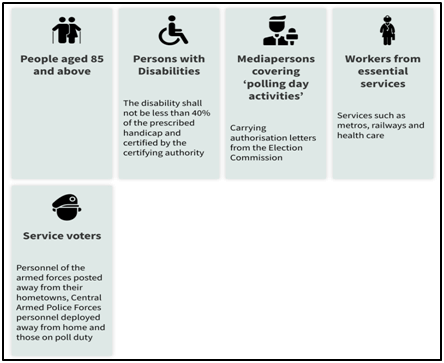
Statement 2 is incorrect
- This decision would allow more than 85 lakh senior citizens and 88.4 lakh persons with disabilities to cast their votes through postal ballots.
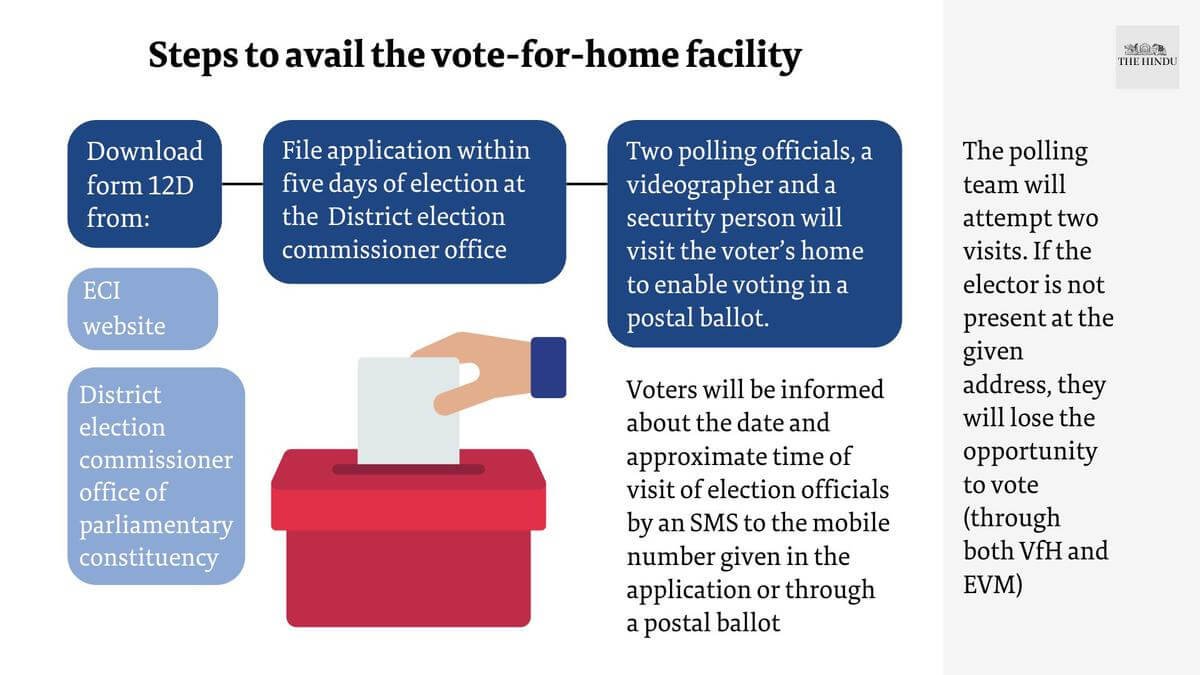
- During the visit, the polling team is expected to follow protocol under the Conduct of Elections Rules, 1961.
- Each team of poll officers is required to:
- Issue postal ballot to each of the Absentee Voters assigned to it,
- Brief the elector about the procedure to be followed for voting through postal ballot,
- Make sure that the elector votes without anyone influencing his/her choice, and ensuring the secrecy of voting, all activities at the address of the elector concerned, according to a November 2022 communique for the Vote-from-home facility.
- The government is also experimenting with remote voting for domestic migrants.
- The Multi Constituency Remote Electronic Voting Machine (RVM) would allow people who migrate within the country for employment and opportunity (almost 450 million, as per the latest 2011 census) to vote for their home constituencies from remote locations.
Answer: (d) Neither 1 nor 2; Difficulty Level: Medium
Incorrect
Explanation
Statement 1 is incorrect
- The Election Commission of India (ECI) has announced the seven-phase poll dates for the 2024 Lok Sabha elections.
- To make the process inclusive and accessible, the ECI has, for the first time in the history of the Lok Sabha elections, extended its ‘vote-from-home’ facility.
- The facility is exclusively reserved for the Persons with Disabilities (PwD) and senior citizens aged 85 and above.
- The Vote from Home facility was previously tried out during Assembly elections in select regions, allowing PwD, senior citizens and people affected by Covid-19 to vote from home.
- In the past 11 Assembly elections, the scheme has helped almost 3.30 lakh people with disabilities and electors above 80 years.

Statement 2 is incorrect
- This decision would allow more than 85 lakh senior citizens and 88.4 lakh persons with disabilities to cast their votes through postal ballots.

- During the visit, the polling team is expected to follow protocol under the Conduct of Elections Rules, 1961.
- Each team of poll officers is required to:
- Issue postal ballot to each of the Absentee Voters assigned to it,
- Brief the elector about the procedure to be followed for voting through postal ballot,
- Make sure that the elector votes without anyone influencing his/her choice, and ensuring the secrecy of voting, all activities at the address of the elector concerned, according to a November 2022 communique for the Vote-from-home facility.
- The government is also experimenting with remote voting for domestic migrants.
- The Multi Constituency Remote Electronic Voting Machine (RVM) would allow people who migrate within the country for employment and opportunity (almost 450 million, as per the latest 2011 census) to vote for their home constituencies from remote locations.
Answer: (d) Neither 1 nor 2; Difficulty Level: Medium
Unattempted
Explanation
Statement 1 is incorrect
- The Election Commission of India (ECI) has announced the seven-phase poll dates for the 2024 Lok Sabha elections.
- To make the process inclusive and accessible, the ECI has, for the first time in the history of the Lok Sabha elections, extended its ‘vote-from-home’ facility.
- The facility is exclusively reserved for the Persons with Disabilities (PwD) and senior citizens aged 85 and above.
- The Vote from Home facility was previously tried out during Assembly elections in select regions, allowing PwD, senior citizens and people affected by Covid-19 to vote from home.
- In the past 11 Assembly elections, the scheme has helped almost 3.30 lakh people with disabilities and electors above 80 years.

Statement 2 is incorrect
- This decision would allow more than 85 lakh senior citizens and 88.4 lakh persons with disabilities to cast their votes through postal ballots.

- During the visit, the polling team is expected to follow protocol under the Conduct of Elections Rules, 1961.
- Each team of poll officers is required to:
- Issue postal ballot to each of the Absentee Voters assigned to it,
- Brief the elector about the procedure to be followed for voting through postal ballot,
- Make sure that the elector votes without anyone influencing his/her choice, and ensuring the secrecy of voting, all activities at the address of the elector concerned, according to a November 2022 communique for the Vote-from-home facility.
- The government is also experimenting with remote voting for domestic migrants.
- The Multi Constituency Remote Electronic Voting Machine (RVM) would allow people who migrate within the country for employment and opportunity (almost 450 million, as per the latest 2011 census) to vote for their home constituencies from remote locations.
Answer: (d) Neither 1 nor 2; Difficulty Level: Medium
-
Question 8 of 10
8. Question
Q8. {MIH – Personalities} Consider the following statements about Shaheed Bhagat Singh:
- He was one of the founder members of Hindustan Republican Association (HRA) in 1924.
- He was hanged till death for involvement in Lahore Conspiracy case and bombing of Central Legislative Assembly (1929).
- He embraced Bolshevism and anarchism to advocate for militant nationalism in the 1930s.
How many of the above statement(s) is/are not correct?
Correct
Explanation
Statement 1 is incorrect
- In 1924 in Kanpur, Shaheed Bhagat Singh became a member of the Hindustan Republican Association, started by Sachindranath Sanyal a year earlier.
- The main organiser of the Association was Chandra Shekhar Azad and Bhagat Singh became very close to him.
- In 1928, Bhagat Singh changed the name of the Hindustan Republican Association to the Hindustan Socialist Republican Association (HSRA).
Statement 2 is incorrect
- Bhagat Singh and B.K. Dutt threw a bomb on 8th April, 1929 in the Central Legislative Assembly, in protest against the passing of two repressive bills, the Public Safety Bill and the Trade Dispute Bill.
- Both Bhagat Singh and B.K. Dutt surrendered thereafter and faced trial so they could further promote their cause.
- They were awarded life imprisonment for this incident.
- However, Bhagat Singh was re-arrested for the murder of J.P. Saunders in the Lahore Conspiracy case.
- He was found guilty in this case and was hanged on 23rd March, 1931 in Lahore along with Sukhdev and Rajguru.
Statement 3 is correct
- Bhagat Singh advocated socialism, and secularism, and opposed capitalism and imperialism.
- Bhagat Singh embraced Bolshevism and anarchism to advocate for militant nationalism in the 1930s.
- He endorsed Gadar Party members’ ideas and opposed Capitalism and Imperialism.
- He envisioned an anarchist society devoid of state control, religion, and private property, advocating for socialism and communism.
Answer: (b) Only two; Difficulty Level: Medium
Incorrect
Explanation
Statement 1 is incorrect
- In 1924 in Kanpur, Shaheed Bhagat Singh became a member of the Hindustan Republican Association, started by Sachindranath Sanyal a year earlier.
- The main organiser of the Association was Chandra Shekhar Azad and Bhagat Singh became very close to him.
- In 1928, Bhagat Singh changed the name of the Hindustan Republican Association to the Hindustan Socialist Republican Association (HSRA).
Statement 2 is incorrect
- Bhagat Singh and B.K. Dutt threw a bomb on 8th April, 1929 in the Central Legislative Assembly, in protest against the passing of two repressive bills, the Public Safety Bill and the Trade Dispute Bill.
- Both Bhagat Singh and B.K. Dutt surrendered thereafter and faced trial so they could further promote their cause.
- They were awarded life imprisonment for this incident.
- However, Bhagat Singh was re-arrested for the murder of J.P. Saunders in the Lahore Conspiracy case.
- He was found guilty in this case and was hanged on 23rd March, 1931 in Lahore along with Sukhdev and Rajguru.
Statement 3 is correct
- Bhagat Singh advocated socialism, and secularism, and opposed capitalism and imperialism.
- Bhagat Singh embraced Bolshevism and anarchism to advocate for militant nationalism in the 1930s.
- He endorsed Gadar Party members’ ideas and opposed Capitalism and Imperialism.
- He envisioned an anarchist society devoid of state control, religion, and private property, advocating for socialism and communism.
Answer: (b) Only two; Difficulty Level: Medium
Unattempted
Explanation
Statement 1 is incorrect
- In 1924 in Kanpur, Shaheed Bhagat Singh became a member of the Hindustan Republican Association, started by Sachindranath Sanyal a year earlier.
- The main organiser of the Association was Chandra Shekhar Azad and Bhagat Singh became very close to him.
- In 1928, Bhagat Singh changed the name of the Hindustan Republican Association to the Hindustan Socialist Republican Association (HSRA).
Statement 2 is incorrect
- Bhagat Singh and B.K. Dutt threw a bomb on 8th April, 1929 in the Central Legislative Assembly, in protest against the passing of two repressive bills, the Public Safety Bill and the Trade Dispute Bill.
- Both Bhagat Singh and B.K. Dutt surrendered thereafter and faced trial so they could further promote their cause.
- They were awarded life imprisonment for this incident.
- However, Bhagat Singh was re-arrested for the murder of J.P. Saunders in the Lahore Conspiracy case.
- He was found guilty in this case and was hanged on 23rd March, 1931 in Lahore along with Sukhdev and Rajguru.
Statement 3 is correct
- Bhagat Singh advocated socialism, and secularism, and opposed capitalism and imperialism.
- Bhagat Singh embraced Bolshevism and anarchism to advocate for militant nationalism in the 1930s.
- He endorsed Gadar Party members’ ideas and opposed Capitalism and Imperialism.
- He envisioned an anarchist society devoid of state control, religion, and private property, advocating for socialism and communism.
Answer: (b) Only two; Difficulty Level: Medium
-
Question 9 of 10
9. Question
Q9. {Prelims – In News} World Happiness Report, is an annual publication of which of the following organization?
Correct
Explanation
- The World Happiness Report is an annual publication of the UN Sustainable Development Solutions Network.
- It is released in partnership by Gallup, the Oxford Wellbeing Research Centre, the UN Sustainable Development Solutions Network (SDSN), and the World Happiness Report’s Editorial Board.
- It measures three main well-being indicators: life evaluations, positive emotions, and negative emotions (described in the report as positive and negative affect).
- The report considers six key factors: social support, income, health, freedom, generosity, and the absence of corruption.
- It was adopted by the UN General Assembly based on a resolution tabled by Bhutan.
- Key Highlights of the 2024 Report:
- For the seventh successive year, Finland topped the list of the happiest countries in the world.
- The other countries in the top ten were Denmark, Iceland, Sweden, Israel, the Netherlands, Norway, Luxembourg, Switzerland and Australia.
- India maintains its position at 126th in the happiness index.
- Surprisingly, it is behind Pakistan, Libya, Iraq, Palestine and Niger.
Answer: (c) UN Sustainable Development Solutions Network; Difficulty Level: Medium
Incorrect
Explanation
- The World Happiness Report is an annual publication of the UN Sustainable Development Solutions Network.
- It is released in partnership by Gallup, the Oxford Wellbeing Research Centre, the UN Sustainable Development Solutions Network (SDSN), and the World Happiness Report’s Editorial Board.
- It measures three main well-being indicators: life evaluations, positive emotions, and negative emotions (described in the report as positive and negative affect).
- The report considers six key factors: social support, income, health, freedom, generosity, and the absence of corruption.
- It was adopted by the UN General Assembly based on a resolution tabled by Bhutan.
- Key Highlights of the 2024 Report:
- For the seventh successive year, Finland topped the list of the happiest countries in the world.
- The other countries in the top ten were Denmark, Iceland, Sweden, Israel, the Netherlands, Norway, Luxembourg, Switzerland and Australia.
- India maintains its position at 126th in the happiness index.
- Surprisingly, it is behind Pakistan, Libya, Iraq, Palestine and Niger.
Answer: (c) UN Sustainable Development Solutions Network; Difficulty Level: Medium
Unattempted
Explanation
- The World Happiness Report is an annual publication of the UN Sustainable Development Solutions Network.
- It is released in partnership by Gallup, the Oxford Wellbeing Research Centre, the UN Sustainable Development Solutions Network (SDSN), and the World Happiness Report’s Editorial Board.
- It measures three main well-being indicators: life evaluations, positive emotions, and negative emotions (described in the report as positive and negative affect).
- The report considers six key factors: social support, income, health, freedom, generosity, and the absence of corruption.
- It was adopted by the UN General Assembly based on a resolution tabled by Bhutan.
- Key Highlights of the 2024 Report:
- For the seventh successive year, Finland topped the list of the happiest countries in the world.
- The other countries in the top ten were Denmark, Iceland, Sweden, Israel, the Netherlands, Norway, Luxembourg, Switzerland and Australia.
- India maintains its position at 126th in the happiness index.
- Surprisingly, it is behind Pakistan, Libya, Iraq, Palestine and Niger.
Answer: (c) UN Sustainable Development Solutions Network; Difficulty Level: Medium
-
Question 10 of 10
10. Question
Q10. {IC – Parliament – State Legislature} Consider the following statements about Disqualification of a Member of the Legislative Assembly:
- Article 194 of the Constitution of India deals with disqualifications for membership of the State Legislative Assembly or Legislative Council.
- A detention of a legislator under a preventive detention law is not a disqualification.
- Indian constitution states a legislator convicted of an offence under the Prevention of Corruption Act (PCA), 1988, should be disqualified for 6 years.
How many of the above statement(s) is/are correct?
Correct
Explanation
Statement 1 is incorrect
- Article 191 of the Constitution of India deals with disqualifications for membership of the State Legislative Assembly or Legislative Council.
- Article 194 guarantees freedom of speech to members in the state legislatures and grants them immunities provided from time to time under the law. Further, it protects an MLA from being tried for their speech or vote in the legislature.
Statement 2 is correct
- According to Representation of the People Act(RPA), 1951, the detention of a person under a preventive detention law is not a disqualification.
Statement 3 is incorrect
- According to Section 8(1) of the Representation of the People Act, 1951, a legislator convicted of an offence under the Prevention of Corruption Act (PCA), 1988, should be disqualified for six years, from the date of conviction, if the punishment is limited to a fine.
- However, if a legislator is sentenced to any term of imprisonment under the PCA, 1988, then he or she should be disqualified from the date of conviction till the entire period of imprisonment and also for a further period of six years from the date of release, the Act says.
- The disqualification can be avoided only if the conviction, and not just the sentence, gets stayed or set aside.
Answer: (a) Only one; Difficulty Level: Medium
Incorrect
Explanation
Statement 1 is incorrect
- Article 191 of the Constitution of India deals with disqualifications for membership of the State Legislative Assembly or Legislative Council.
- Article 194 guarantees freedom of speech to members in the state legislatures and grants them immunities provided from time to time under the law. Further, it protects an MLA from being tried for their speech or vote in the legislature.
Statement 2 is correct
- According to Representation of the People Act(RPA), 1951, the detention of a person under a preventive detention law is not a disqualification.
Statement 3 is incorrect
- According to Section 8(1) of the Representation of the People Act, 1951, a legislator convicted of an offence under the Prevention of Corruption Act (PCA), 1988, should be disqualified for six years, from the date of conviction, if the punishment is limited to a fine.
- However, if a legislator is sentenced to any term of imprisonment under the PCA, 1988, then he or she should be disqualified from the date of conviction till the entire period of imprisonment and also for a further period of six years from the date of release, the Act says.
- The disqualification can be avoided only if the conviction, and not just the sentence, gets stayed or set aside.
Answer: (a) Only one; Difficulty Level: Medium
Unattempted
Explanation
Statement 1 is incorrect
- Article 191 of the Constitution of India deals with disqualifications for membership of the State Legislative Assembly or Legislative Council.
- Article 194 guarantees freedom of speech to members in the state legislatures and grants them immunities provided from time to time under the law. Further, it protects an MLA from being tried for their speech or vote in the legislature.
Statement 2 is correct
- According to Representation of the People Act(RPA), 1951, the detention of a person under a preventive detention law is not a disqualification.
Statement 3 is incorrect
- According to Section 8(1) of the Representation of the People Act, 1951, a legislator convicted of an offence under the Prevention of Corruption Act (PCA), 1988, should be disqualified for six years, from the date of conviction, if the punishment is limited to a fine.
- However, if a legislator is sentenced to any term of imprisonment under the PCA, 1988, then he or she should be disqualified from the date of conviction till the entire period of imprisonment and also for a further period of six years from the date of release, the Act says.
- The disqualification can be avoided only if the conviction, and not just the sentence, gets stayed or set aside.
Answer: (a) Only one; Difficulty Level: Medium
Newsletter Updates
Subscribe to our newsletter and never miss an important update!
Assured Discounts on our New Products!
Related Posts

January 18 2024 Prelims Practice Questions (PPQs)
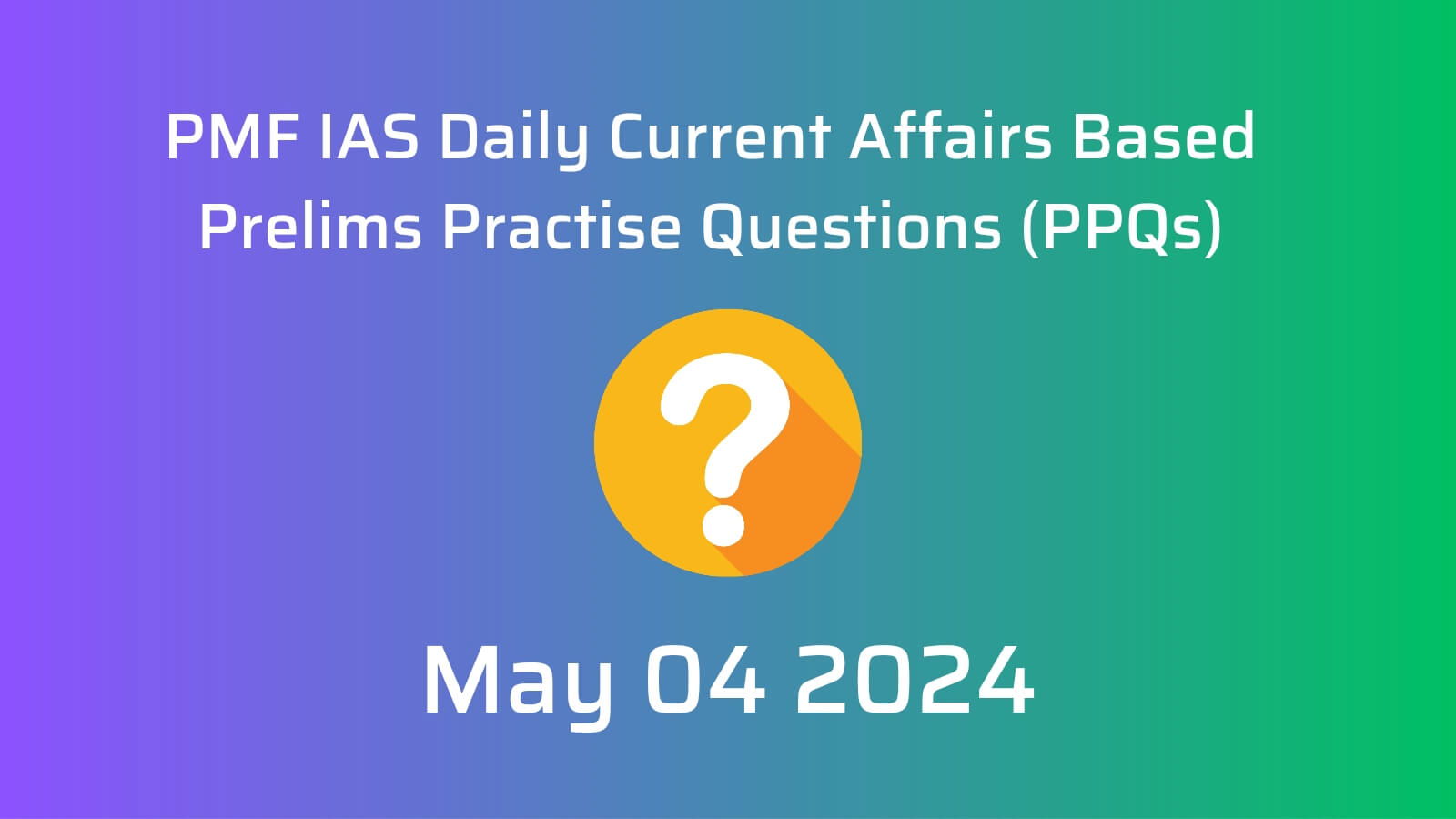
May 04 2024 Prelims Practice Questions (PPQs)

Daily Prelims Practise Questions (PPQs) – October 20 2023
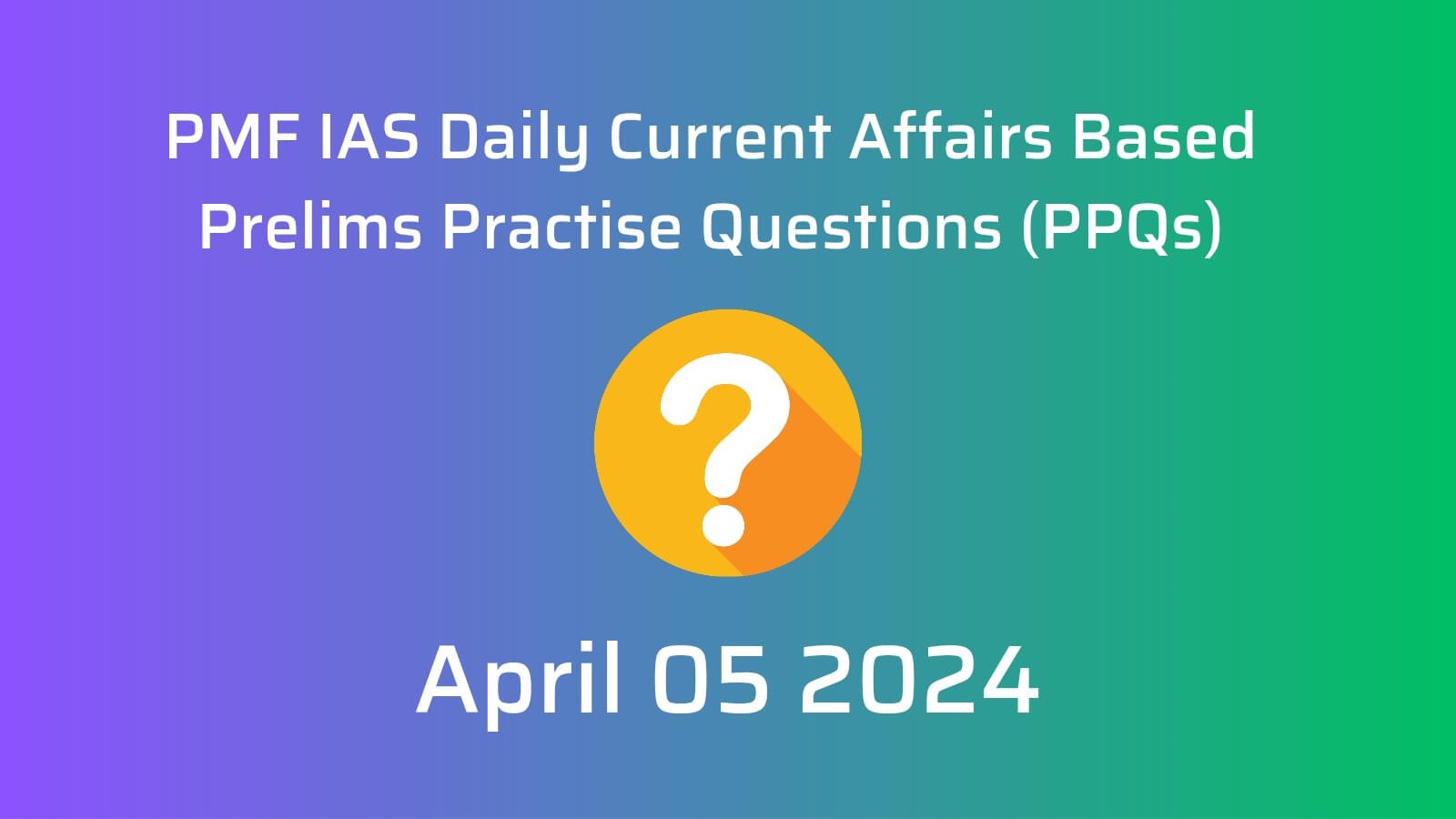
April 05 2024 Prelims Practice Questions (PPQs)

December 13 2023 Prelims Practice Questions (PPQs)
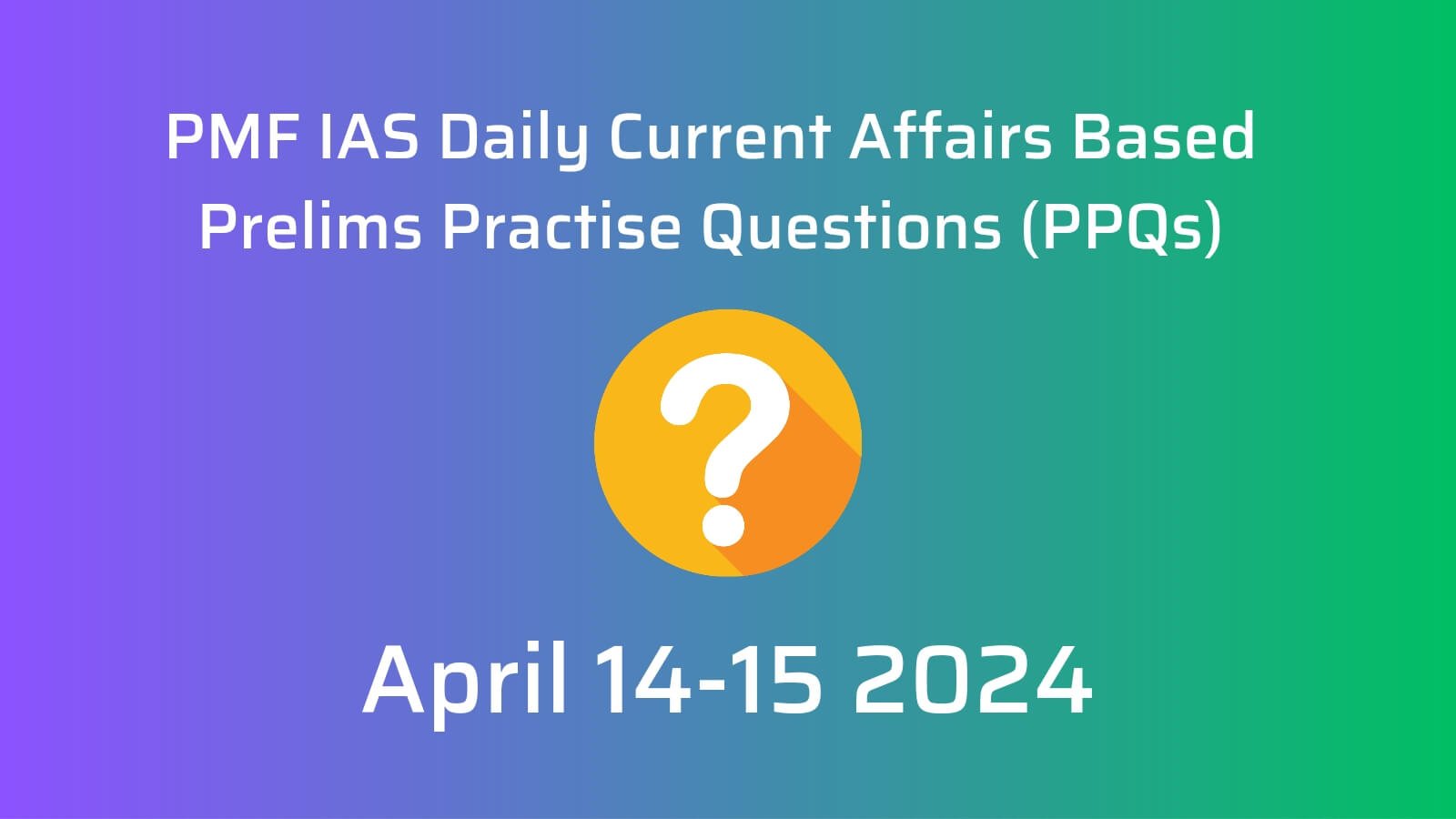
April 14-15 2024 Prelims Practice Questions (PPQs)

January 31 2024 Prelims Practice Questions (PPQs)





![PMF IAS Environment for UPSC 2022-23 [paperback] PMF IAS [Nov 30, 2021]…](https://pmfias.b-cdn.net/wp-content/uploads/2024/04/pmfiasenvironmentforupsc2022-23paperbackpmfiasnov302021.jpg)




